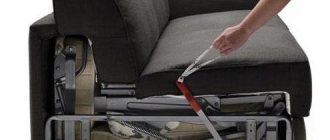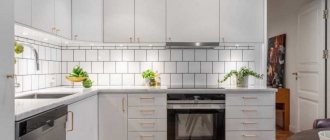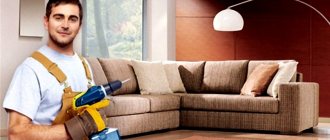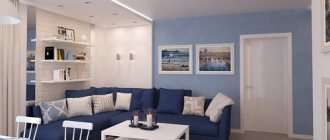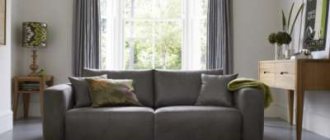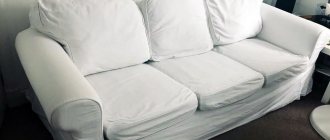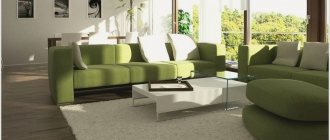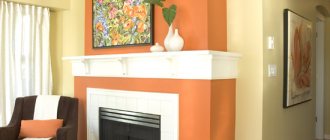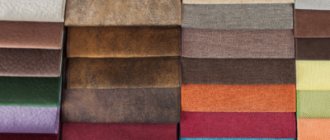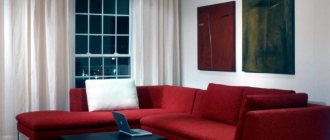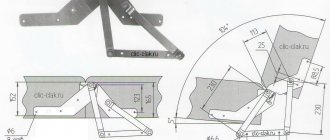Options
Sofa frame
The first method involves using beams left over after the construction of large buildings as a material. In addition to timber, you will need the following materials:
- foam rubber, which can be bought in a special store;
- a zipper 21 cm long, which will be required when sewing a cover;
- three 7 cm zippers used on pillows;
- upholstery material, such as tapestry;
- corner and metal mesh.
Natural wood
Traditionally reliable raw materials that have relatively high strength properties. Along with this, wood is an environmentally friendly raw material. The types of wood used for frames may vary, as can the prices of furniture.
According to experts, it is better to purchase products with a frame made of oak, ash and other hardwoods. In this case, pine is a less durable wood, but it will also be a good option. It is worth noting that the wood should not have any inclusions from knots and should be dry.
Back
Frame corner sofa
No less important in this matter is the collection of a strong backrest for the sofa. Since this version of the sofa is quite simple and does not provide for a folding system, the backrest is made in the same way with a frame base. The backrest is fixed to the base using thick metal corners as tightly as possible. How much the back will be tilted is up to you to decide, based on your feelings.
ANDERSSEN sofas
The ANDERSSEN upholstered furniture factory is a member of the March 8 holding and offers a wide range of high quality furniture:
- corner sofas;
- sofa beds;
- couches;
- chair-beds;
- children's sofas;
- poufs;
- chairs, etc.
The ANDERSSEN upholstered furniture factory uses the best materials for frames and high-quality fillers in production that meet all current standards. Furniture from ANDERSSEN means reliability, a wide range of upholstery types, colors and shapes, as well as practicality, high performance and convenience of each model.
All articles
Armor mesh
In the third step of the work, you will make a support grid on the sofa frame, necessary to support the seat cushions. This is done using a metal armored mesh from an old bed. By fixing the mesh on a wooden base with metal brackets, you will get the desired result. For greater reliability, glue several transverse ones onto the longitudinal frame beams.
How to choose the right sofa made of natural wood to buy for a long time
- First of all, pay attention to the neatness of the stitching on the upholstery, find out what materials were used in the manufacture of the frame and filling. Of course, you can walk around the sofa from all sides and look under it, but you will not be able to see the contents hidden under the upholstery fabric. The quality of the seams is an indicator of how the manufacturer controls the manufacturing process.
- Check with the seller: PPU or a spring block is used as a filler and what density of polyurethane foam is used, it is advisable to look at the product data sheet. If the foam has a density less than 25, dents will form in the seat, and such furniture cannot be repaired.
- The choice of fabrics today is very large; manufacturers have such an indicator as “fabric category”, which serves to indicate quality. Typically, the higher the category of fabric, the denser it is.
- If you are choosing a sofa for daily use as a bed, then checking the transformation mechanism is a mandatory step. The seller must provide you with the opportunity to unfold and assemble it yourself, and if the furniture will be used by a teenager, a woman or an elderly person, then the system should work very easily. As for the thickness and high-quality painting of mechanisms and fittings, these points also need to be checked and made sure of their quality.
- It is also necessary to remember that the shape and size of the sofa should be selected in accordance with the dimensions of the room. Decide on the location in advance. It is possible to install a corner sofa - great, such a model will take up the provided corner and there will still be a lot of free space left. For a small room, it is better to buy a straight 2- or 3-seater model with the ability to fold out. Products on sale are about 2 m wide, and when unfolded, you will get a comfortable sleeping place for two. This option is especially popular among buyers living in small apartments.
- A new way to shop, especially when you have a clear idea of what you want, is online shopping. All major manufacturers have their own sites on the Internet, in addition to the usual representative offices in shopping centers. There you can see the full range of sofas and see what the product looks like in different upholsteries. Modern furniture centers are also not lagging behind and provide their space to leading manufacturers and suppliers: here you can get to know the products better, sit and lie down on the sofas to feel comfortable.
- What should you be especially careful with? For example, the following not-so-honest marketing technique is very common: you saw it in your mailbox or were given a booklet with attractive prices for sofas. But, having come to the store specifically for one of them, it turns out that the promotional item has “run out”; then the seller will immediately try to sell another product at regular prices, seeing your interest. And here it’s up to you to decide whether it’s worth purchasing goods from those who use similar methods of attraction.
Upholstery
Upholstery fabric
Proceed with upholstery in the following order:
- cut two pieces of foam rubber corresponding in size to the sofa backrest and at least 15 cm thick;
- cover the cut out elements with material, for example, tapestry, connecting them with a zipper;
- Using decorative tape, attach the mattresses to the supporting structure. You will get the tape from upholstery material and Velcro. Secure one end of the tape to the frame with small nails, and the other to the tapestry cover;
- Having sewn three covers from the same upholstery material and equipped them with zippers, fill them with the rest of the foam rubber. You should get three pillows.
Which sofa frame is better to choose?
When buying this piece of furniture, you need to take into account that the base can be a load-bearing structure or have decorative properties. With a hidden structure, only its performance is important. It’s good if it’s made of wood, because it’s a reliable and natural material.
Wood deserves attention, and if the frame plays a decorative role, it has a very aesthetic appearance. In addition, wooden armrests can be complemented with shelves, tables and made not only beautiful, but also useful
- Tweet
- Share
- Tell
Shield
Self-assembly of the sofa
This method is suitable for people who do not have woodworking skills. This option is a little simpler and to implement it you need to stock up:
- two used door leaves;
- metal staples;
- wood hemp;
- foam;
- upholstery material.
Wooden version
The base and back of this sofa model will be two used wooden door leaves. You will need to first clean them of old coatings and dirt, and then treat them with a grinding machine.
Next, the doors are painted in the color of your choice, while trying to ensure that it matches the overall interior of the room in which the sofa will be installed in the future. You may prefer finishing the wooden surface with veneer.
Using nails, fasten one sash to a wooden stump of the appropriate size, and then use metal staples and glue to secure the second part (the back) to it.
After this, start making the mattress: cut out the foam rubber of the same size as the seat and cover it with thick fabric (matting is ideal for this). Already on top of this material a bright fabric of good quality will be stretched.
The main requirement is the construction of the most durable and reliable frame foundation. It bears the entire main load, and if you neglect this requirement, you can get injured during operation, and it will not last long. Based on this, you can choose a different base material that meets the requirements.
You can play with the finished design in any way you like, it all depends on your preferences and imagination.
Combined
As a rule, combined frames are based on wood or metal, and auxiliary materials from which individual components are made. The production of such sofas is cheaper, and the quality is usually not inferior to analogues. In most cases, the following materials are additional.
- Multilayer plywood. The cheapest furniture is made with its use. Due to technical features, frames using plywood are susceptible to moisture and temperature changes. Load resistance depends on the thickness of the material. It is recommended to purchase furniture with a plywood sheet thickness of at least 12 mm. It is usually combined with wood, less often with metal.
- MDF. It is produced by pressing wood fibers with an adhesive called ligin. Since natural glue is used, the material is completely safe for humans, sofas using it can be used, including in children's rooms. It is not inferior in strength to spruce boards. Often combined with wood. Among the disadvantages, one can note the rather high cost, which somewhat reduces the popularity of this combination.
- Chipboard. Its characteristics are similar to plywood, but it is less susceptible to temperature changes. It is characterized by low resistance to any loads. The plate can break even with a slight load. Such furniture is one of the cheapest. It can be combined with wood or metal, it all depends on the specific model. It is considered not the most environmentally friendly material; the glue used for pressing contains formaldehyde resins.
- Wood and metal. One of the best options. On the one hand, the product receives increased strength. The frame resists mechanical stress well. On the other hand, wood can be used as flooring, providing more comfortable use. Wood is also placed in the form of decorative overlays, covering metal elements. Birch is often used in this combination as a soft but beautiful material with insufficient strength. When choosing, pay attention to the quality of welded and bolted connections.
When deciding which sofa frame to choose, you should consider where it will be used. This is one of the important points to choose. If you plan to use the furniture constantly, especially as a sleeping place, you should pay attention to durable frames made of metal or wood, as well as their combinations.
Corner sofa
Corner design
To make a corner sofa, it is not necessary to use complex joints, for example, tenon products, or expensive materials. For work, we suggest using the following material, the volume and quantity of which depends on the size:
- timber 30×50 mm;
- chipboard;
- Fiberboard;
- plywood, thickness 5 and 15 mm;
- self-tapping screws and wood screws;
- nails;
- synthetic winterizer, with a density of 140–170 g/day;
- batting;
- foam rubber, thickness 20 and 40 mm with a density of at least 30 kg/m3;
- glue for foam rubber and wood glue;
- foam crumbs;
- furniture fabric;
- lifting mechanism;
- furniture legs 5 cm high.
It is not recommended to use nails when connecting parts. They will quickly become loose, and the sofa will creak and, as a result, fall apart. Therefore, it is best to use self-tapping screws for connections.
As for the tool, for work you will need:
- wood hacksaw;
- miter box;
- screwdriver;
- stapler;
- sewing machine;
- knife.
Configurations and sizes of corner sofa blocks
Each structural block is made of a frame, which is based on timber, chipboard and plywood. The internal space in blocks 1 and 2 can be used rationally by making removable covers. To support them, a 20x30 mm beam is fixed around the perimeter of the frame. It is installed below the top cut to the thickness of the cover plate. To make it easier to lift the lid, you can drill holes in it for your fingers.
Frame design block 1
Blocks 1 and 2 are identical in design. The only difference is their size. The first block is 100x60 cm in size, and the second is 60x60. It is the second block that will be located in the corner of the structure and connect the first and third blocks. As for the third block, you can make a drawer-seat in it. Due to this, the usable area of the sofa will increase. To do this, you can install a retractable or rotating mechanism.
The drawer will also be equipped with a chipboard lid. While assembling it is not difficult, difficulties may arise when making the legs. Why? When sliding the drawer into the body of the sofa, they will interfere. Therefore, instead of legs, it is necessary to increase the height of the front side of the drawer. When unfolding the corner sofa, it will serve as a support platform. To make the drawer easy to pull out, you can attach furniture wheels to the bottom.
Block 3
The cover for the third block (indicated in the diagram) can also be made removable. For example, you can fold bed linen inside.
The size of the seat cushion should be equal to the size of the drawer. Therefore, when the drawer is pulled out, the pillow is removed from the back and placed on it instead of the mattress.
Design of the backrest of a corner sofa
Now it's time to make the backrest for the corner sofa. The manufacturing process looks like this:
- Place 3 beams horizontally and, as in the illustration, connect them with vertical posts. The height of the back in our case will be 105 cm.
- The lower second beam will be located at a height of 25 cm. They will serve to fix the backrest to the sofa.
- The top beam will be used as the basis for fastening the sheathing and provide the necessary rigidity of the structure.
- The frame is sheathed on both sides with plywood 5 mm thick.
- To avoid snags and unevenness when laying upholstery fabric, sand all corners with sandpaper.
- Glue thin foam rubber onto the side and front surfaces, due to this the upholstery will be soft.
Finally, all that remains is to cover the entire sofa, including the backs, with the selected material.
Fastening the upholstery
Before doing this, take all the measurements, and then cut out the fabric with an allowance for the hem. You can fasten the material with a stapler. The mounting location should be on the invisible part of the panel end. Make sure that the fabric does not wrinkle at the corners. As for the manufacture of pillows for the back and seat, they can be made from foam rubber with a density of 140–170 g/day and a thickness of at least 10 cm. You will also need to sew a cover with a zipper. This will allow you to remove the cover and wash it if necessary.
Selection of fillings for sofas
Upholstered furniture is becoming increasingly popular every year. For this reason, manufacturers try to please every consumer. There are sofas, couches and other functional interior items that differ from each other by hard or soft seats. This criterion directly depends on the type of filler used.
Spring blocks
They are included in the base of many sofas. Thanks to the spring block, the product remains elastic even after prolonged use. The use of this durable material is ideal for sofa beds that serve as a sleeping place. The springs have a reliable weave; highly elastic steel is used for their manufacture.
Filler made of polyurethane foam (PPU)
In the production of polyurethane foam, synthetic polymers are mixed, which contributes to the production of foam material. Characterized by high wear resistance, elasticity and durability. Environmental friendliness makes the product safe even for newborn children. Polyurethane foam has a high degree of rigidity, which allows it to quickly return to its original shape. Such furniture will last about 12 years.
Holofiber
The material consists of a spatial spiral. Thanks to this microstructure, its shape is preserved and easily restored. Other types of fillers are inferior to holofiber in terms of hygiene. It is also characterized by moisture resistance and comfort.
Foam rubber
Constant improvement of the material allows us to produce various types: latex, rigid, molded and lightweight. Produced in accordance with modern quality standards.
Sintepon
The material is distinguished by quality, environmental friendliness, elasticity, and elasticity. Also, light-ozone aging and fungal contamination do not pose a danger to it. Sintepon does not absorb moisture; with its help, furniture becomes embossed and especially soft.
Skyron, Britbond and Durafil fillers
Thanks to these modern polymers, the seats and backs of sofas have the required density. Such materials are characterized by high wear-resistant properties and resistance to deformation.
Vatnik
For production, several layers of special fabric are used, the layer is cotton wool 5 cm thick. Thanks to this filler, the sleeping place is especially soft.
Sofa bed
The sofa can perform several functions. So, it can be used for short rest during the day and for full rest at night. Let's consider the sequence of work. Diagrams will be attached to the description, so you can clearly see the manufacturing process.
Sidewalls
Assembling the sidewalls
From boards 19 mm thick, cut two pieces 775 mm and 381 mm long. From these you assemble an A/B frame. Panel D is cut from plywood to the same size. First, the frame is glued together, and after the glue dries, it is screwed together with self-tapping screws. After this, cut out the bosses C. Thanks to them, the secure fastening of the bed ties will be ensured. The thickness of the boss is equal to the thickness of the frame. These parts are glued to the frame and set aside to dry.
Now it's time to cut out workpiece D (dimensions 381x775 mm). Attach the cutter to the router collet. You will use it to make 3x6 mm folds around the entire perimeter of the workpiece, but only from the front side. After this, take 2 panels that will be located on the inside of the sides and connect them with double-sided tape face to face. On one of the panels, mark the places for making holes Ø19 mm, which will indicate the end and beginning of the slot. Then drill holes through both panels at the intended location.
Making holes and chamfering
Next, draw lines between the holes. After separating the panels, cut the slots with a jigsaw. To make sure the slots are even, run a Ø19 mm dowel inside them. If necessary, sandpaper can be used to refine areas where the size does not correspond to 19 mm. Finally, chamfer the edges of the slots, 3 mm wide, from the front side of the part. Paint the bottom of the folds with stain, this way you will emphasize the shadow gap that forms between the side panel edging and the edge of the panel.
Manufacturing step by step
Now you can try on the made panels to the previously made frames. At the edges, both parts must completely match. After these manipulations, cut out the side and bottom/top edging parts E and F. They must be cut with an allowance of up to 25 mm in length. To join them, the edges are cut at an angle of 45°. The edging is connected to the frame using glue and screws. If necessary, the assembled parts are sanded with sandpaper.
Legs and armrests
To make the legs, cut the block parts G, leg ties I, spacers J and face panels H. Connect the blanks G and H together so that the sides and bottom sides of the parts meet. Then, using a clamp, fasten the workpieces to the ties I and make countersink holes.
A countersink hole is made for the head of a countersunk screw. To do this, it is best to insert a screw with a head of the required diameter into the drill chuck. When using a drill, chips can occur, especially when drilling holes in plywood.
The resulting hole is used to connect the ties and legs. Mill a 3mm chamfer around the bottom end of the legs. After this, sand the resulting element with sandpaper. If you want to give the workpieces a special tone or color, you can treat them with stain.
The J spacers need to be connected to the undersides of the sidewall. Make sure there are no protrusions on the sides. Next, the leg is attached and it also needs to be aligned with the edges of the workpiece F. Make a hole through the ties I, countersink it and connect the parts with self-tapping screws. On the opposite side it is necessary to make an armrest of the appropriate size. The armrest should extend beyond the edges at the front and back and be flush with the interior panels.
Back and seat
Back and seat
To make the back and seat, you should cut out several blanks: post M, top crossbar N, bottom crossbar O, side bars Q, lining R, back S and front seat crossbar T. For manufacturing, you can use a 50 mm board. As for the seat panel U and backrest P, they can be done later.
Racks
Now drill holes and counterbores in the side bars Q and the M pillar, and attach the linings R to the side bars Q.
Countering is a countersinking process that involves cleaning the end surface. As a rule, counterboring is performed in the form of mounted heads that have end teeth. This process is performed under the washer, nuts or thrust rings.
Make grooves 38 mm wide in the racks. Also make the folds at the end of the front crossbar T 76 mm wide, and at the end of the top crossbar N and the rear S - 38 mm.
seat
Attaching the stops
Next, in parts M, N, O, Q, S and T, make tongues 6 mm deep. To do this you need to use a router.
Blank
A tongue means a longitudinal protrusion on the edge of a board or beam. It fits into a matching groove in another board with a similar shape. This connection method is known as tongue and groove.
After this, take the workpiece N and T and mill a rounding with a radius of 12 mm on them. Also make 15° bevels. At the ends of the part N, T and S, make counterbores with a depth of 8 mm, using a Forstner drill Ø10 mm, and make mounting holes in the center of the counterbore.
Forstner drill
At the next stage, it’s time to manufacture the back and seat P and U. Having cut them to the specified dimensions along the perimeter of the part, you should mill a 10 mm wide fold along the entire perimeter. Ridges should be formed during this process. They should fit into the tongues of the workpieces T, S, Q, O, N and M. Next, you need to lubricate the tongues T, S, R/Q, O, M and N and, fixing them with a clamp, glue them to the panels U and P. After previously holes made on parts T, S, N and M, drill a hole in the panel and secure the parts with self-tapping screws. Afterwards you need to glue wooden plugs/plugs into the counterbores. Finally, these plugs should be sanded flush with the workpiece.
Now you need to make V stops at one end with a bevel. It must be pressed with a clamp to the seat in the designated place. Then drill the holes, countersink them and fasten them with a self-tapping screw. Grind a 3 mm chamfer around the end and cut a piece 57 mm long. As a result, you will need to make 4 such parts and secure them into the holes of the backrest posts. At this stage, you still need to make four wooden washers, 6 mm thick and Ø127 mm. Sand these spacers smooth.
Finishing and assembly
To connect the backs, you need to cut out the drawers L. Immediately before assembling the sofa bed, make sure that there are no sharp corners or chips. If necessary, they should be sanded with sandpaper. Finally, all that remains is the sheathing and final assembly. By closely adhering to the diagrams and the step-by-step instructions provided, you will be able to do all the work yourself.
"Derivatives" of the tree
2. Plywood.
Multilayer plywood is glued together from thin sheets of veneer (usually birch), pressed under pressure and at high temperature, dry and very durable. There is virtually no risk of deformation for such material. The thicker the plywood (this figure ranges from 12 to 25 mm), the more reliable and durable it is. At the same time, it is noticeably cheaper than wood. One drawback: the length of the plywood sheet is limited - usually it is no more than 150 cm, so it is not suitable for every part. For example, on long drawers (the side parts of the sofa that give the necessary rigidity to the structure), chipboard is used instead of jointed plywood. The plywood frame is lightweight, just like wood.
- 1 of 1
On the picture:
The frame made of multilayer plywood is lightweight and practically not subject to deformation. Furniture with such a frame is cheaper than wood.
Sofa book
Making upholstered furniture is not an easy process. It requires accuracy, attentiveness and hard work. We invite you to familiarize yourself with the instructions for making a book sofa, which, when unfolded, will have dimensions of 1400×2200 mm, and when folded, 1000×2200 mm. To do this you will need to prepare the following material:
- board 25 mm thick: 1000×50 (12 pcs.);800×50 (2 pcs.);800×200 (2 pcs.); 1900×200 (2 pcs.);
- timber: 50×50×200 (4 pcs.);40×50×330 (4 pcs.);40×60×530 (6 pcs.);40×60×1790 (2 pcs.);40×60× 1890 (2 pieces);
- glue intended for foam rubber;
- staples for stapler 16 and 10 mm;
- self-tapping screws 89D and 51D;
- nails 70 and 100 mm;
- nuts 8 and 8 mm;
- furniture bolts: 6×70 (8 pcs.); 6×40 (4 pcs.); 8×120 (4 pcs.);
- non-woven fabric – 4 m;
- foam;
- fabric 6 m/p and width 1.4 m;
- Fiberboard 1.7x2.75, thickness 3.2mm (1 sheet);
- holders (64 pcs.) and wooden slats (32 pcs.);
- legs 4 pcs.
- 1 set of mechanism for sofa book.
Also prepare the following set of tools:
- stapler;
- open-end wrenches;
- set of drills;
- drill;
- screwdriver;
- hammer;
- roulette;
- pencil;
- square;
- hacksaw.
If you have all of the above, you can start working.
Step-by-step instruction
The first step is to make frames for the armrest, linen drawer, backrest and seat. First, let's assemble the laundry drawer. To do this you need to use:
- 4 beams 40×50 (50×50) 200 mm long;
- 2 boards 25 mm, 50 mm wide and 800 mm long;
- 2 boards 800 mm long and 200 mm wide;
- 2 boards 25 mm thick (40 mm thick or 20 mm plywood), 1900 mm long and 200 mm wide.
You assemble a frame from boards 800 and 1900 mm long, reinforcing the structure with transverse slats. A fiberboard of the appropriate size is nailed to the bottom of the structure. Next you need to assemble the back and seat of the sofa. The size of the sleeping area should be quite spacious, so take this into account when calculating. So, assemble 2 equal frames, size 1890x650 mm, from 40x60 mm timber. The timber frame is best fastened with self-tapping screws. To do this, pre-drill holes Ø8 mm to a depth of 10 mm. After making the frame, it is necessary to secure the slats to hold the mattress.
Assembling the slats
At the next stage, you make the armrests. For this purpose, you can use chipboard with a thickness of 25 mm. Cut out the left and right armrest according to the dimensions indicated in the photo:
Back assembly
Next you should make a wooden frame. In this case, it should be 20 mm shorter than the size of the chipboard. Afterwards, you make holes Ø8.5 mm in the frame and insert 8x120 mm bolts into them, and after that the frame is sewn up. Also drill holes on the linen drawer, only Ø10 mm.
Drawer base
Now the individual parts of the sofa are assembled into one whole. A special transformation mechanism is also used. When assembling two frames, take into account the fact that when unfolded there is at least 10 mm between them, and when folded the seat does not protrude beyond the armrest.
Frame assembly
After this, the frame must be sheathed. Foam rubber and prepared fabric are used here. Don’t forget to also cover the armrests with fabric and foam.
Finishing touches
Sofa on a wooden frame and its features
Natural wood is now very popular, because this type of furniture is distinguished by its high environmental friendliness. It will fit into any interior, be it classic or high-tech. This piece of furniture will make the atmosphere in your home especially cozy and homely.
To make the frame of a corner or straight upholstered sofa, oak, walnut, ash, pine or other types of wood can be used. Thanks to the development of modern technologies, the tree species from which the structure is made almost do not matter, because they are treated with various strengthening, fire-fighting and antifungal mixtures, which improves their condition and increases their service life. The main elements are connected with special bolts, so they do not creak during operation, and if this even occurs, they can simply be lubricated.
It is very important that the material used for the sofa frame meets quality standards. The wood must be well dried and free of knots. If the humidity exceeds 8%, such furniture is unlikely to last long.
Among the main advantages of wood are:
- Orthopedic effect. Such products are much softer.
- Safety. This is especially important if there are children in the house. Soft material will also reduce injuries.
- Naturalness.
- The ability to improve the microclimate of the room.
Transformable sofa - its types
Types of transformable sofa
There are several types of transformable sofas:
- Book. This model is one of the simplest. By unfolding the sofa, an additional sleeping place is formed. And for convenience, springs are installed in the back.
- Eurobook. By slightly pulling the seat towards you, the sofa is conveniently unfolded, and pillows are placed on the resulting free space.
- Roll-out. The lower part is movable. As a result, a full-fledged sleeping place is extended. This model has the main drawback - rapid wear of the mechanisms.
- Dolphin sofa. This type of structure is most often made angular. When it is extended, two sleeping places are obtained. And an additional sleeping place rises from under the fixed part.
- Sofa accordion. This model is quite compact, consisting of 3 parts that unfold and fold.
Video: assembling a Eurobook on a plywood block
Video: making a Chester sofa
If you still decide to buy a sofa or have it made to order, then contact an online furniture store. On the Internet you can find inexpensive options of various shapes: both straight and angular.
How to choose the best sofa for the living room, children's room and kitchen
- To the living room.
If you are choosing furniture for a recreation area, it would be a good idea to opt for a large corner model with high backs and soft, deep seats. The frame of such products must be wooden; additions from pressed plates are possible. As for the upholstery material, choose it according to your taste, but focus on breathable natural fabrics like linen, cotton or wool. And it’s good if they contain synthetics. Velor, plush, flock or even velvet are also suitable.
In the sitting area, in front of the TV, it is advisable to place a straight two- or three-seater sofa. If you prefer compact furniture, opt for a metal frame - but in this case this is not at all necessary. Choose the back height that is most convenient for you. The same applies to the softness of sofa cushions. But the upholstery material should be easy to clean. Watching TV without drinks and various goodies is not much fun, but it contributes to soiling of the upholstery. Here you should choose a good sofa made of genuine leather or its substitute. If you prefer fabric, you can go with polyester or acrylic.
- To the nursery.
Children prefer compact sofas in bright colors. But they must be made from safe materials: a wooden base and hypoallergenic lint-free fabrics. Linen, cotton or chenille work well here. Of course, high-quality furniture costs accordingly - but the child’s health is more expensive. Therefore, it is better to choose it in stores selling goods from well-known companies. The shape and decor of the sofa in this case also matters. Make sure that the furniture does not have sharp corners or hard edges that could cause injury.
- To the kitchen.
It is best to equip the dining area with special kitchen furniture. The seats of such a sofa should be about 50 cm from the floor, with not too soft pillows. Try to choose a metal frame - painted, chrome-plated or stainless steel. You can, of course, buy a sofa with a wooden frame, but then it should be carefully looked after. Many people prefer kitchen furniture made of oak, larch or other moisture-resistant types of wood, but products of this type are often produced only to order.
Some families purchase sets made from laminated chipboard or laminated MDF boards. But this choice is justified only if in five years you are ready to buy new kitchen furniture. And be sure to take a sofa that has high cutouts on the legs and well-sealed edges. Wet cleaning in the kitchen is a common thing, and the press swells and becomes unusable due to moisture that has penetrated into it. If your kitchen is small, choose a sofa with drawers under the seats or internal boxes - this will save space.
And one more piece of advice. When choosing a sofa for the kitchen, pay attention to the quality of the upholstery. In this case, only moisture-resistant ones are suitable, which do not accumulate odors and are easily cleaned of dust and dirt. It can be eco-leather, microfiber or upholstery made of synthetic fabrics. A tapestry (especially a colorful one) will also be good - it hides various types of dirt well. If you wish, purchase a sofa with linen or cotton upholstery - but only if the material is treated with water-repellent impregnation.
Sofa color
Knowing the characteristics of the most common shades, you need to use them not only taking into account your own perception, but also with knowledge of the psychology of color and its influence on a person’s emotional state. This is the only way to create a harmonious environment in the room where the sofa for daily sleep will be located.
Dark colors of the sofa are associated with rigor, elegance, and tradition. In addition, dark upholstery is easier to care for, since dirt and wear are less visible on it. However, many may find such neutral colors boring and not luxurious enough.
Bright, rich colors of upholstery can enliven any interior, give it brightness and provide a good mood to the people who will spend time in this room. But at the same time, an overly saturated color can suppress the psychological state of people who sleep on it every day with its brightness. Also, stains and dirt are visible on bright colors.
A light choice of upholstery colors for a sofa for daily sleep may also not always be justified. Light colors are prone to rubbing; wear and household dirt are more visible on them.
Sofa upholstery
Choosing upholstery for a sofa that you buy for daily sleep is not an easy task. A wide variety of upholstery materials can surprise even the most demanding client.
Upholstery materials vary:
- according to the type of fibers used, from which the material is formed, upholstery can be: natural and synthetic;
- by type of fabric formation: woven and non-woven upholstery;
- according to the method of coloring the fabric: upholstery can be plain or patterned.
Upholstery for sofas can be made:
- made of cotton;
- from velor;
- from chenille;
- from flock;
- from matting;
- from tapestry;
- jacquard
- leather;
- from leatherette.
Cotton
Cotton fabrics are harmless to the human body, non-toxic and pleasant to the body. The fabric is highly breathable and absorbs moisture. But the big disadvantage of such upholstery is the poor wear resistance of the material. The average service life of a sofa with such upholstery, subject to daily use, can be only 1-2 years.
Velours
Velor is a dense fabric with a small pile, pleasant to the touch and appearance, reminiscent of velvet. This upholstery has an excellent appearance, does not attract dust and hair, is easy to dry clean, and can withstand the claws and teeth of animals (although folk does this even better). In addition, velor is a hypoallergenic and environmentally friendly fabric.
However, velor also has a number of disadvantages. Firstly, he is quite capricious and demanding of care. Despite the fact that it is easy to carry out dry cleaning, with wet cleaning and removing stains, problems may arise, including the use of dry cleaning. If used incorrectly, the pile can be irrevocably damaged, and some types of stains are very difficult to remove from velor. Secondly, the fabric pile wears out over time, which leads to a deterioration in the appearance of the sofa. Thus, velor is at the same time a durable fabric due to its strength, but at the same time it loses its beauty and appearance.
Jacquard
Jacquard upholstery provides a dense, elegant base. The material is practically not subject to abrasion and fading, which is its absolute advantage. The weaving in jacquard is usually complex, the pattern is exquisite. A sofa with jacquard upholstery will delight its owners for many years.
However, as with velor, it is not easy to care for - you can only dry clean it. Jacquard is also sensitive to moisture, which is a disadvantage. In addition, this fabric is very hard and slippery, which not everyone will like.
Jacquard may be suitable for pet owners, as the frequency of weaving and the strength of the fabric can withstand cat claws.
Flock
Flock upholstery is very attractive and durable. In addition, its significant advantage is environmental friendliness. In its appearance, flock resembles velvet. Includes both synthetic and natural fibers.
In a small apartment where the bedroom is a living room, this material for sofa upholstery is optimal to choose. The elegant appearance and pleasant-to-touch material will please even the most demanding customers. The fabric is easily cleaned from household dirt; pet claws do not leave visible marks on the flock.
The only disadvantage of this fabric is its ability to absorb various odors well. Also, despite the fact that flock is usually presented in almost all price categories - from budget to expensive, most often its cost is more expensive than a number of other upholstery options.
Chenille
A very common material for upholstering sofas is chenille. The pile is soft to the touch and consists of both natural and synthetic fibers. Very pleasant and durable fabric usually comes in a wide variety of colors. It is environmentally friendly, wear-resistant, does not fade or deform. Chenille can be easily cleaned from dust and household dirt using a vacuum cleaner or a brush with coarse bristles. However, it is completely unstable to moisture. Even a glass of water spilled on the sofa can turn into a minor disaster, since the sofa will immediately lose its appearance, and in order to get rid of the stain, you will have to call a chemical cleaner.
In addition, chenille is very susceptible to snags, so it is not recommended for cat owners to choose such upholstery. In addition, the price of this fabric is quite high, so it is not suitable for a budget sofa.
Tapestry
When choosing upholstery for a sofa, special attention should be given to the tapestry. This material is durable and strong, and has high wear resistance. The basis of the tapestry is made of wool and cotton threads, complemented by a small amount of synthetic fibers. The tapestry is made using environmentally friendly bases, so it is quite suitable for choosing sofa upholstery for daily sleep. This upholstery is easy to clean, both dry and wet.
Among the disadvantages of tapestry, we can note the possibility of abrasion, as well as fading in sunlight. Therefore, it is recommended not to place sofas with tapestry upholstery near windows. In addition, the cost of this upholstery is high.
Gozhka
Matting upholstery is characterized by strength and wear resistance. This material consists of natural and synthetic fibers. It is very attractive and simple at the same time. A sofa made of matting is easy to maintain. Dust and dirt are wiped off with a damp cloth. The matting is available in a wide range of colors and patterns.
However, this is the least desirable option for pet owners as this fabric is very easy to snag. Also, the matting is rough to the touch, which may not be to everyone’s liking.
Leather and leatherette
Leather and leatherette (for example, eco-leather) are not the best choice of sofa upholstery for daily sleep.
Thanks to the use of these materials, the sofa will acquire a noble appearance and will be quite durable. Although in this regard, leatherette is inferior to natural material, as it often has a tendency to abrasion. With constant use, the first cracks in the upholstery may appear within six months to a year after purchasing the sofa.
Caring for a leather sofa is simple; cracking and abrasion are possible only over a long period of use or when choosing low-quality materials. But leather or leatherette is not entirely pleasant when in contact with the body, it can stick and cause inconvenience, so it is better not to choose these materials for a sofa that will serve as a daily sleeping place.
Tips for choosing sofa upholstery
When choosing sofa upholstery, you should pay attention to:
- on the color of the material, which should be combined with the existing interior;
- on the wear resistance of the selected upholstery.
If you have pets in the apartment, you should pay attention to the sofa upholstery, which uses a large weave of fairly thick threads. If you do not take this recommendation into account, soon after it appears in the apartment, the upholstery of the sofa will have marks from the claws of your pets.
| Upholstery name | Suitable for daily sleep | Pet friendly | Easy to care for | Abrasion resistance | Durability | Moisture resistance | Expensive cost | ||
| Velours | + | + | — | — | + | — | — | ||
| Gozhka | + | — | + | + | + | — | — | ||
| Chenille | + | — | + | + | + | — | + | ||
| Flock | + | + | + | + | + | + | — | ||
| Jacquard | + | + | — | + | + | — | — | ||
| Cotton | + | — | + | — | — | — | — | ||
| Leather | — | — | + | + | + | + | + | ||
| Leatherette | — | — | + | — | — | + | — | ||
| Tapestry | + | — | + | + | + | + | + | ||
Features of the material
Before you start working with plywood, it is advisable to have an idea of the features of this unique material - this will allow you to properly make furniture that will last for many years. The advantage of plywood is that it is easy to work with; it does not require the use of expensive special tools for processing.
The main features of plywood include the following:
- Low cost, which allows you to independently produce functional, practical and aesthetically attractive furnishings for little money: children's furniture, shelving and cabinets, cabinets and chests of drawers, kitchen furniture, decorative screens and partitions.
- To make unique furniture from plywood you do not need to have any special skills.
- Plywood is an ideal material for making children's furniture, as it is environmentally friendly and safe.
- Plywood can be decorated in various ways, which significantly expands the range of products.
Natural pattern on the surface of plywood furniture
Plywood has different thicknesses, which allows you to choose the required material depending on the purpose of the part
